Kyocera 1500 User Manual

1500
before using the copier for easy reference
All rights reserved. No part of this material may be reproduced or transmitted in any form or by any means, electronic or mechanical, including photocopying, recording or by any information storage and retrieval system, without permission in writing from the Publisher.
Legal Restriction On Copying
•It may be prohibited to copy copyrighted material without permission of the copyright owner.
•It is prohibited under any circumstances to copy domestic or foreign currencies.
•Copying other items may be prohibited.

Introduction to this Operation Guide
The explanations contained in this operation guide have been separated into different sections in order to allow even those using a copier for the first time to use this machine efficiently, properly and with relative ease.
A basic introduction to each section can be found below for reference. Refer to the related section when using this copier.
Section 1 IMPORTANT! PLEASE READ FIRST.
This section contains explanations on information that is necessary for you to know prior to using this copier for the first time after purchase.
For example, it contains notes and cautions on installation and operation that should be strictly obeyed in order to ensure its safe and proper operation.
Section 2 NAMES OF PARTS
This section contains explanations on the names and functions of the parts of the copier and its operation panel.
Section 3 PREPARATIONS
This section contains explanations on loading copy paper and attaching the face-up tray.
Section 4 BASIC OPERATION
This section contains explanations on the basic procedures required to make simple copies.
Section 5 COPY FUNCTIONS
This section contains explanations on using the various convenient functions of this copier.
Section 6 COPY DEFAULT SETTINGS
This section contains explanations on changing the various default settings available for adjusting the copier to fit your copy needs.
Section 7 OPTIONAL EQUIPMENT
This section contains explanations on the optional equipment that are available for use with this copier.
Section 8 TROUBLESHOOTING
This section contains explanations on handling problems that may occur during operation of this copier, such as when an error indication appears or if a paper jam occurs.
Section 9 MAINTENANCE AND OPERATION INFORMATION
This section contains explanations on maintaining the copier in proper condition and on replacing the toner container, as well as information on the specifications for this copier.
Symbols in this guide
This Operation Guide contains certain symbols to indicate points of caution and additional information that is important for you to know.
The symbols and their meanings are indicated below.
IMPORTANT!
This symbol indicates information on procedures that should or should not be performed in order to avoid trouble.
NOTE(S)
This symbol indicates information on additional explanations or procedures for your reference.
i

CONTENTS
Energy Star Program ....................................................................... |
iv |
Please read this Operation Guide before using the copier. Keep it |
|
close to the copier for easy reference. ............................................... |
v |
Section 1
IMPORTANT! PLEASE READ FIRST. 1-1
CAUTION LABELS ....................................................................... |
1-1 |
INSTALLATION PRECAUTIONS ................................................ |
1-2 |
PRECAUTIONS FOR USE ............................................................ |
1-3 |
Section 2 |
|
NAMES OF PARTS .................................. |
2-1 |
|
|
Main Body ....................................................................................... |
2-1 |
Operation panel .............................................................................. |
2-4 |
Section 3 |
|
PREPARATIONS ..................................... |
3-1 |
Loading paper ................................................................................. |
3-1 |
Note when adding paper .......................................................... |
3-1 |
Loading paper into a drawer ................................................... |
3-1 |
Setting paper on the multi-bypass tray .................................. |
3-5 |
Thick Paper mode .................................................................... |
3-9 |
Attaching the face-up tray ........................................................... |
3-10 |
Section 4 |
|
BASIC OPERATION ................................ |
4-1 |
|
|
Basic copying procedure ................................................................. |
4-1 |
Making enlarged and reduced copies ............................................ |
4-4 |
Zoom mode ................................................................................ |
4-4 |
Preset Zoom mode .................................................................... |
4-5 |
Low Power mode ............................................................................ |
4-6 |
Off mode .......................................................................................... |
4-7 |
Section 5 |
|
COPY FUNCTIONS ................................. |
5-1 |
Layout modes ................................................................................. |
5-1 |
2-in-1 ......................................................................................... |
5-1 |
4-in-1 ......................................................................................... |
5-5 |
Selecting the borderline ........................................................... |
5-6 |
Selecting the order of 4-in-1 layout ......................................... |
5-7 |
Sort mode ........................................................................................ |
5-9 |
Program function .......................................................................... |
5-10 |
Registering the program ........................................................ |
5-10 |
Using programmed settings to make copies ......................... |
5-10 |
Section 6 |
|
COPY DEFAULT SETTINGS ................. |
6-1 |
|
|
Available default items .................................................................. |
6-1 |
Accessing and changing the default settings ................................ |
6-6 |
Checking the total copy count and printing out a report ........... |
6-12 |
Section 7 |
|
OPTIONAL EQUIPMENT ...................... |
7-1 |
|
|
Document Processor ................................................................ |
7-1 |
Paper Feeder ............................................................................ |
7-4 |
Additional Memory .................................................................. |
7-4 |
Section 8 |
|
TROUBLESHOOTING ............................ |
8-1 |
If one of the following indications is displayed ............................ |
8-1 |
If paper jams .................................................................................. |
8-3 |
Misfeed location indicators ..................................................... |
8-3 |
Cautions ................................................................................... |
8-3 |
Removal procedures ................................................................ |
8-4 |
If other trouble occurs .................................................................... |
8-9 |
Section 9 |
|
MAINTENANCE AND OPERATION |
|
INFORMATION ....................................... |
9-1 |
|
|
Cleaning the copier ........................................................................ |
9-1 |
Replacing the toner container ....................................................... |
9-2 |
Specifications ................................................................................. |
9-6 |
Main Body ................................................................................ |
9-6 |
Document Processor (option) .................................................. |
9-7 |
Paper Feeder (option) .............................................................. |
9-7 |
Additional Memory (option) .................................................... |
9-7 |
Environmental Specifications ....................................................... |
9-8 |
Optional equipment ....................................................................... |
9-9 |
Appendix: Functions and settings combination
chart ...................................................................... |
9-10 |
ii
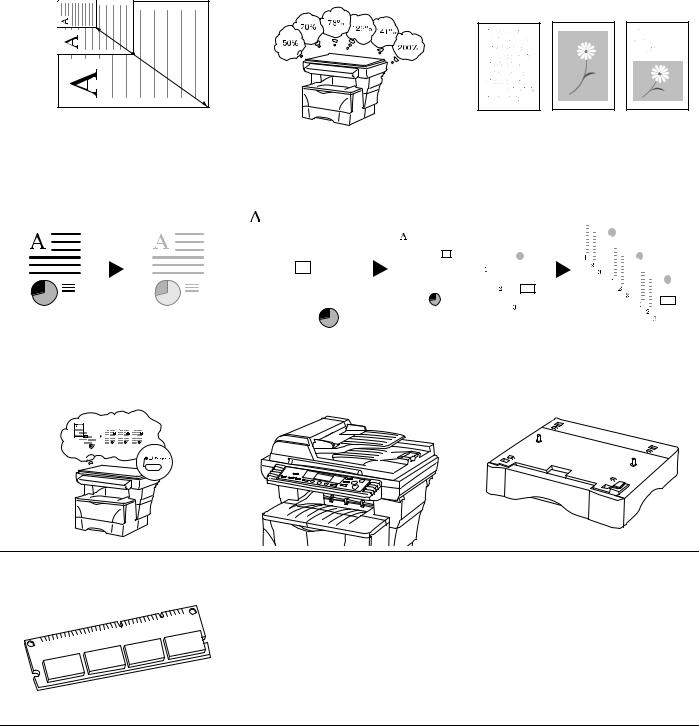
MAKING FULL USE OF THE COPIER’S ADVANCED FUNCTIONS
1 |
Enlarging/reducing copies to a |
2 |
Copying at a previously registered |
3 |
Making clear reproductions of |
|
desired size between 50% and 200% |
|
magnification ratio |
|
photographs |
|
<Zoom mode> (See page 4-4) |
|
<Preset Zoom mode> |
|
<Image quality selection> |
|
|
|
(See page 4-5) |
|
(See page 4-1) |
50% |
200% |
4 |
Saving on toner use |
5 |
|
Making one copy from either two or 6 |
|
|
|
Sorting automatically |
|||||||||||||||||||||||||||||||||||||||||||||||||
|
<Eco-Copy mode> (See page 4-1) |
|
|
|
|
four originals |
|
|
|
<Sort mode> (See page 5-9) |
|||||||||||||||||||||||||||||||||||||||||||||||
|
|
|
|
|
|
|
|
|
<Layout modes> (See page 5-1) |
|
|
|
|
|
|
|
|
|
|
|
|
|
|
|
|
|
|
|
|
|
|
|
|
|
|
|
|
||||||||||||||||||||
|
|
|
|
|
|
|
|
|
|
|
|
|
|
|
|
|
|
|
|
|
|
|
|
|
|
|
|
|
|
|
|
|
|
|
|
|
|
|
|
|
|
|
|
|
|
|
|
|
|
|
|
|
|
|
|
|
|
|
|
|
|
|
|
|
|
|
|
|
|
|
|
|
|
|
|
|
|
|
|
|
|
|
|
|
|
|
|
|
|
|
|
|
|
|
|
|
|
|
|
|
|
|
|
|
|
|
|
|
|
|
|
|
|
|
|
|
|
|
|
|
|
|
|
|
|
|
|
|
|
|
|
|
|
|
|
|
|
|
|
|
|
|
|
|
|
|
|
|
|
|
|
|
|
|
|
|
|
|
|
|
|
|
|
|
|
|
|
|
|
|
|
|
|
|
|
|
|
|
|
|
|
|
|
|
|
|
|
|
|
|
|
|
|
|
|
|
|
|
|
|
|
|
|
|
|
|
|
|
|
|
|
|
|
|
|
|
|
|
|
|
|
|
|
|
|
|
|
|
|
|
|
|
|
|
|
|
|
|
|
|
|
|
|
|
|
|
|
|
|
|
|
|
|
|
|
|
|
|
|
|
|
|
|
|
|
|
|
|
|
|
|
|
|
|
|
|
|
|
|
|
|
|
|
|
|
|
|
|
|
|
|
|
|
|
|
|
|
|
|
|
|
|
|
|
|
|
|
|
|
|
|
|
|
|
|
|
|
|
|
|
|
|
|
|
|
|
|
|
|
|
|
|
|
|
|
|
|
|
|
|
|
|
|
|
|
|
|
|
|
|
|
|
|
|
|
|
|
|
|
|
|
|
|
|
|
|
|
|
|
|
|
|
|
|
|
|
|
|
|
|
|
|
|
|
|
|
|
|
|
|
|
|
|
|
|
|
|
|
|
|
|
|
|
|
|
|
|
|
|
|
|
|
|
|
|
|
|
|
|
|
|
|
|
|
|
|
|
|
|
|
|
|
|
|
|
|
|
|
|
|
|
|
|
|
|
|
|
|
|
|
|
|
|
|
|
|
|
|
|
|
|
|
|
|
|
|
|
|
|
|
|
|
|
|
|
|
|
|
|
|
|
|
|
|
|
|
|
|
|
|
|
|
|
|
|
|
|
|
|
|
|
|
|
|
|
|
|
|
|
|
|
|
|
|
|
|
|
|
|
|
|
|
|
|
|
|
|
|
|
|
|
|
|
|
|
|
|
|
|
|
|
|
|
|
|
|
|
|
|
|
|
|
|
|
|
|
|
|
|
|
|
|
|
|
|
|
|
|
|
|
|
|
|
|
|
|
|
|
|
|
|
|
|
|
|
|
|
|
|
|
|
|
|
|
|
|
|
|
|
|
|
|
|
|
|
|
|
|
|
|
|
|
|
|
|
|
|
|
|
|
|
|
|
|
|
|
|
|
|
|
|
|
|
|
|
|
|
|
|
|
|
|
|
|
|
|
|
|
|
|
|
|
|
|
|
|
|
|
|
|
|
|
|
|
|
|
|
|
|
|
|
|
|
|
|
|
|
|
|
|
|
|
|
|
|
|
|
|
|
|
|
|
|
|
|
|
|
|
|
|
|
|
|
|
|
|
|
|
|
|
|
|
|
|
|
|
|
|
|
|
|
|
|
|
|
|
|
|
|
|
|
|
|
|
|
|
|
|
|
|
|
|
|
|
|
|
|
|
|
|
|
|
|
|
|
|
|
|
|
|
|
|
|
|
|
|
|
|
|
|
|
|
|
|
|
|
|
|
|
|
|
|
|
|
|
|
|
|
|
|
|
|
|
|
|
|
|
|
|
|
|
|
|
|
|
|
|
|
|
|
|
|
|
|
|
|
|
|
|
|
|
|
|
|
|
|
|
|
|
|
|
|
|
|
|
|
|
|
|
|
|
|
|
|
|
|
|
|
|
|
|
|
|
|
|
|
|
|
|
|
|
|
|
|
|
|
|
|
|
7 |
Memorizing frequently used |
8 |
A full range of optional equipment is |
|
|||||||||||||||||||
|
settings <Program function> |
|
available |
|
|||||||||||||||||||
|
(See page 5-10) |
• Document Processor (See page 7-1) |
• Paper Feeder (See page 7-4) |
||||||||||||||||||||
|
|
|
|
|
|
|
|
|
|
|
|
|
|
|
|
|
|
|
|
|
|
|
|
|
|
|
|
|
|
|
|
|
|
|
|
|
|
|
|
|
|
|
|
|
|
|
|
• Additional Memory (See page 7-4)
iii

We have determined as a participating company in the International Energy Star Program that this product is compliant with the standards laid out in the International Energy Star Program.
About the International Energy Star Program
International Energy Star Program has as its basic goals the promotion of efficient energy use and the reduction of the environmental pollution that accompanies energy consumption by promoting the manufacture and sale of products that fulfill program standards.
International Energy Star Program standards require that copies come equipped with a “Low Power Mode” where energy consumption is reduced after a certain amount of time elapses since the device was last used, as well as an “Off Mode” where the device automatically turns itself off after there is no activity within a set amount of time. When the copier includes printer and fax functions, the printer and fax must enter a “Low Power Mode” where power consumption is automatically reduced after a certain amount of time elapses since they were last used, and they must also support a “Sleep Mode” where power consumption is reduced to a minimum when there is no activity within a set amount of time.
This product is equipped with the following features as a result of its compliance with International Energy Star Program standards.
Low Power Mode
The device automatically enters “Low Power Mode” when 15 minutes have passed since the device was last used. The amount of time of no activity that must pass before “Low Power Mode” is activated may be lengthened. See “Low Power mode” for more information.
Off Mode
The device automatically enters “Off Mode” when 60 minutes have passed since the device was last used. The amount of time of no activity that must pass before “Off Mode” is activated may be lengthened. For more information see “Off mode”.
Paper Recycling
The Energy Star Program encourages the use of environmentally friendly recycled paper. Your sales or service representative can provide information about recommended paper types.
iv

Please read this Operation Guide before using the copier. Keep it close to the copier for easy reference.
The sections of this guide and parts of the copier marked with symbols are safety warnings meant to protect the user, other individuals and surrounding objects, and ensure correct and safe usage of the copier. The symbols and their meanings are indicated below.
DANGER: Indicates that serious injury or even death will very possibly result from insufficient attention to or incorrect compliance with the related points.
WARNING: Indicates that serious injury or even death may result from insufficient attention to or incorrect compliance with the related points.
CAUTION: Indicates that personal injury or mechanical damage may result from insufficient attention to or incorrect compliance with the related points.
Symbols
The  symbol indicates that the related section includes safety warnings. Specific points of attention are indicated inside the symbol.
symbol indicates that the related section includes safety warnings. Specific points of attention are indicated inside the symbol.
 ..........[General warning]
..........[General warning]
 ..........[Warning of danger of electrical shock]
..........[Warning of danger of electrical shock]
 ..........[Warning of high temperature]
..........[Warning of high temperature]
The  symbol indicates that the related section includes information on prohibited actions. Specifics of the prohibited action are indicated inside the symbol.
symbol indicates that the related section includes information on prohibited actions. Specifics of the prohibited action are indicated inside the symbol.
..........[Warning of prohibited action]
..........[Disassembly prohibited]
The z symbol indicates that the related section includes information on actions which must be performed. Specifics of the required action are indicated inside the symbol.
..........[Alert of required action]

 ..........[Remove the power plug from the outlet]
..........[Remove the power plug from the outlet]
..........[Always connect the copier to an outlet with a ground connection]
Please contact your service representative to order a replacement if the safety warnings in this Operation Guide are illegible or if the guide itself is missing. (fee required)
v
vi
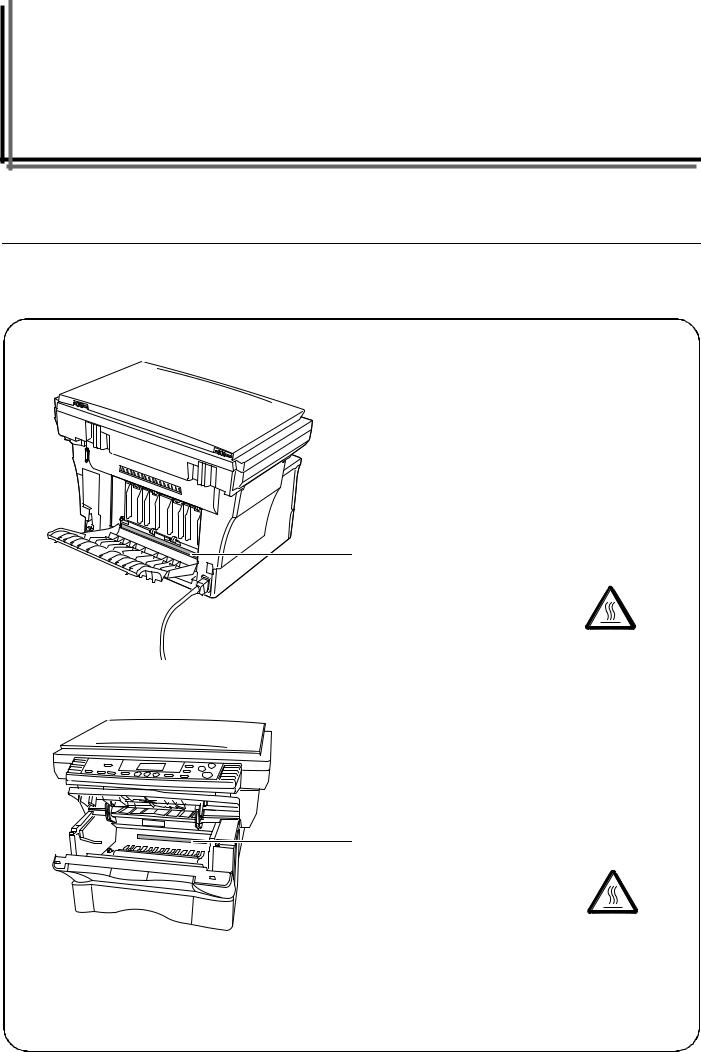
Section 1 IMPORTANT! PLEASE READ
FIRST.
 CAUTION LABELS
CAUTION LABELS
Caution labels have been attached to the copier at the following locations for safety purposes.
BE SUFFICIENTLY CAREFUL to avoid fire or electric shock when removing a paper jam or when replacing toner.
Label 1
High temperature inside.
Do not touch parts in this area, because there is a danger of getting burned. ..............................................
Label 2
High temperature inside.
Do not touch parts in this area, because there is a danger of getting burned. ..............................................
NOTE: DO NOT remove these labels.
1-1
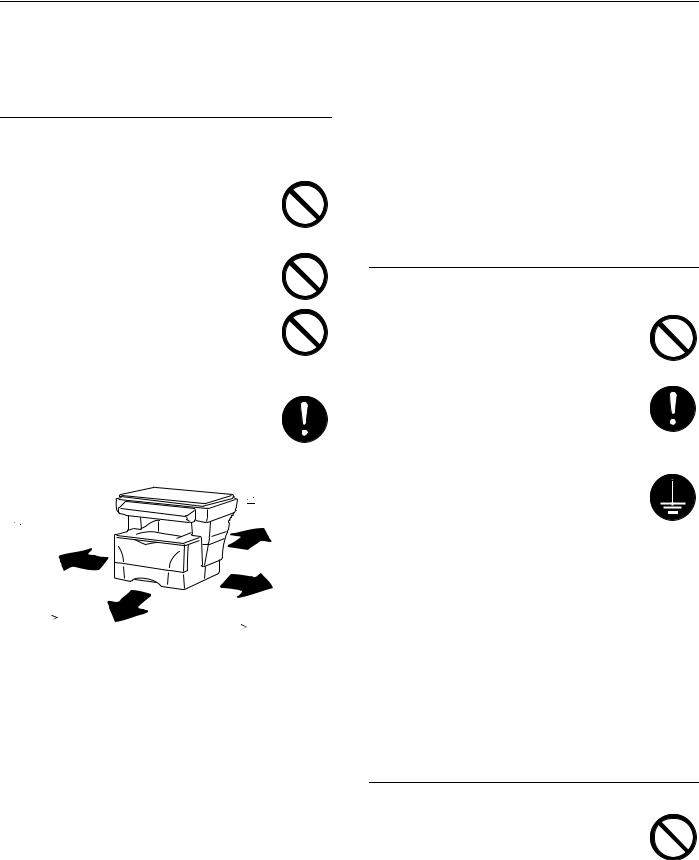
 INSTALLATION PRECAUTIONS
INSTALLATION PRECAUTIONS
Environment
 CAUTION
CAUTION
Avoid placing the copier on or in locations which are unstable or not level. Such locations may cause the copier to fall down or fall over. This type of situation presents a danger of personal injury or damage to the
copier. .............................................................................
Avoid locations with humidity or dust and dirt. If dust or dirt become attached to the power plug, clean the plug to avoid the danger of fire or electrical shock. .......................
Avoid locations near radiators, heaters, or other heat sources, or locations near flammable items, to avoid the danger of fire.
To keep the copier cool and facilitate changing of parts and maintenance, allow access space as shown below. Leave adequate space, especially around the vents, to allow air to be properly ventilated out of the copier.
Rear:
 11 13/16" Left: 30 cm
11 13/16" Left: 30 cm
 11 13/16"
11 13/16"
30 cm
Front: |
Right: |
||||||
|
|
39 |
3/8" |
||||
|
|
|
|
11 |
13/16" |
||
|
|
|
|||||
|
|
100 cm |
|
|
|||
|
|
|
|||||
|
|
|
|
30 cm |
|||
|
|
|
|
|
|
||
Other precautions
Adverse environmental conditions may affect the safe operation and performance of the copier. Install in an air-conditioned room (recommended room temperature: around 68°F (20°C), humidity: around 65%) and avoid the following locations when selecting a site for the copier.
•Avoid locations near a window or with exposure to direct sunlight.
•Avoid locations with vibrations.
•Avoid locations with drastic temperature fluctuations.
•Avoid locations with direct exposure to hot or cold air.
•Avoid poorly ventilated locations.
During copying, some ozone is released, but the amount does not cause any ill effect to one's health. If, however, the copier is used over a long period of time in a poorly ventilated room or when making an extremely large number of copies, the smell may become unpleasant. To maintain the appropriate environment for copy work, it is suggested that the room be properly ventilated.
Power supply/Grounding the copier
 WARNING
WARNING
DO NOT use a power supply with a voltage other than that specified. Avoid multiple connections in the same outlet. These types of situations present a danger of fire or
electrical shock. .........................................................
Plug the power cord securely into the outlet. If metallic objects come in contact with the prongs on the plug, it may cause a fire or
electric shock. .............................................................
Always connect the copier to an outlet with a ground connection to avoid the danger of fire or electrical shock in case of an electric short. If an earth connection is not possible, contact your service representative. ................................
Other precautions
Connect the power plug to the closest outlet possible to the copier.
The power supply cord is used as the main disconnect device. Ensure that the socket/outlet is located/installed near the equipment and is easily accessible.
Handling of plastic bags
 WARNING
WARNING
Keep the plastic bags that are used with the copier away from children. The plastic may cling to their nose and mouth causing
suffocation. ..................................................................
1-2
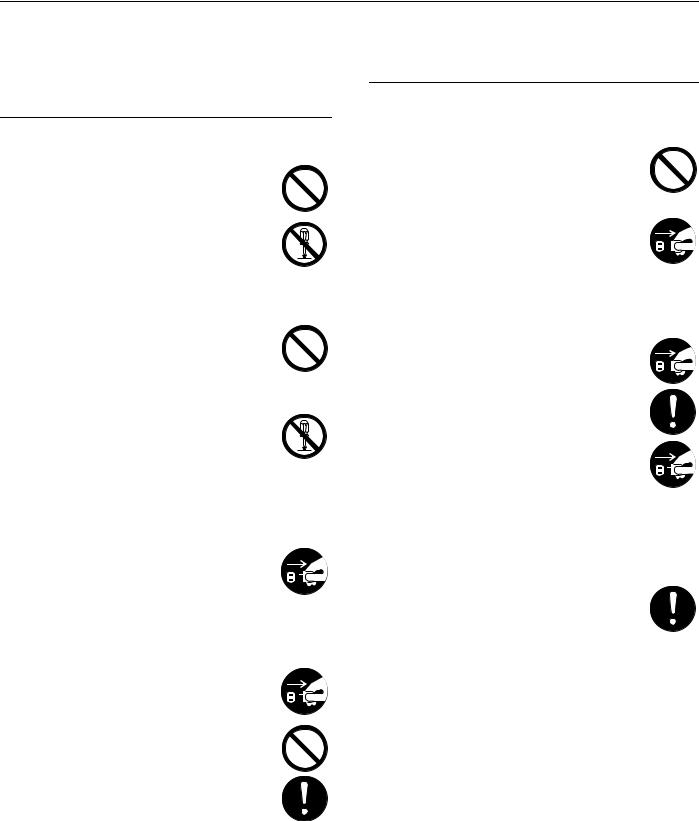
 PRECAUTIONS FOR USE
PRECAUTIONS FOR USE
Cautions when using the copier
 WARNING
WARNING
DO NOT place metallic objects or containers with water (flower vases, flower pots, cups, etc.) on or near the copier. This of situation presents a danger of fire or electrical shock should they fall inside. ..................................
DO NOT remove any of the covers from the copier as there is a danger of electrical shock from high voltage parts inside the copier. ....
DO NOT damage, break or attempt to repair the power cord. DO NOT place heavy objects on the cord, pull it, bend it unnecessarily or cause any other type of damage.
These types of situations present a danger of fire or electrical shock. ...................................
NEVER attempt to repair or disassemble the copier or its parts as there is a danger of fire, electrical shock or damage to the laser. If the laser beam escapes, there is a danger of it causing blindness............................................
If the copier becomes excessively hot, smoke appears from the copier, there is an odd smell, or any other abnormal situation occurs, there is a danger of fire or electrical shock. Turn the power switch OFF ({) immediately, BE ABSOLUTELY CERTAIN to remove the power plug from the outlet and then contact your service representative. .....
If anything harmful (paper clips, water, other fluids, etc.) falls into the copier, turn the power switch OFF ({) immediately. Next, BE ABSOLUTELY CERTAIN to remove the power plug from the outlet to avoid the danger of fire or electrical shock. Then contact your service representative. ...
DO NOT remove or connect the power plug with wet hands, as there is a danger of electrical shock. ..............................................
ALWAYS contact your service representative for maintenance or repair of internal parts.
 CAUTION
CAUTION
DO NOT pull the power cord when removing it from the outlet. If the power cord is pulled, the wires may become broken and there is a danger of fire or electrical shock. (ALWAYS grasp the power plug when removing the power cord from the outlet.) .........................
ALWAYS remove the power plug from the outlet when moving the copier. If the power cord is damaged, there is a danger of fire or electrical shock. .............................................
If the copier will not be used for a short period of time (overnight, etc.), turn the power switch OFF ({).
If it will not be used for an extended period of time (vacations, etc.), remove the power plug from the outlet for safety purposes during the time the copier is not in use. ..................
ALWAYS hold the designated parts only when lifting or moving the copier. ................
For safety purposes, ALWAYS remove the power plug from the outlet when performing cleaning operations. .......................................
If dust accumulates within the copier, there is a danger of fire or other trouble. It is therefore recommended that you consult with your service representative in regard to cleaning of internal parts. This is particularly effective if accomplished prior to seasons of high humidity. Consult with your service representative in regard to the cost of cleaning the internal parts of the copier. .....
1-3

Other precautions
DO NOT place heavy objects on the copier or cause other damage to the copier.
DO NOT open the upper front cover, turn off the power switch, or pull out the power plug during copying.
When lifting or moving the copier, contact your service representative.
Do not touch electrical parts, such as connectors or printed circuit boards. They could be damaged by static electricity.
DO NOT attempt to perform any operations not explained in this handbook.
CAUTION: Use of controls or adjustments or performance of procedures other than those specified herein may result in hazardous radiation exposure.
Do not look directly at the light from the scanning lamp as it may cause your eyes to feel tired or painful.
Cautions when handling consumables
 CAUTION
CAUTION
DO NOT attempt to incinerate the toner
container. Dangerous sparks may cause
burns. .............................................................
Keep the toner container out of the reach of
children. .........................................................
If toner happens to spill from the toner
container, avoid inhalation and ingestion, as
well as contact with your eyes and skin. ......
•If you do happen to inhale toner, move to a place with fresh air and gargle thoroughly with a large amount of water. If coughing develops, contact a physician.
•If you do happen to ingest toner, rinse your mouth out with water and drink 1 or 2 cups of water to dilute the contents of your stomach. If necessary, contact a physician.
•If you do happen to get toner in your eyes, flush them thoroughly with water. If there is any remaining tenderness, contact a physician.
•If toner does happen to get on your skin, wash with soap and water.
DO NOT attempt to force open or destroy the toner container. .............................................
Other precautions
After use, ALWAYS dispose of the toner container in accordance with Federal, State and Local rules and regulations.
Store all consumables in a cool, dark location.
If the copier will not be used for an extended period of time, remove the paper from the drawer, return it to its original package and reseal it.
1-4
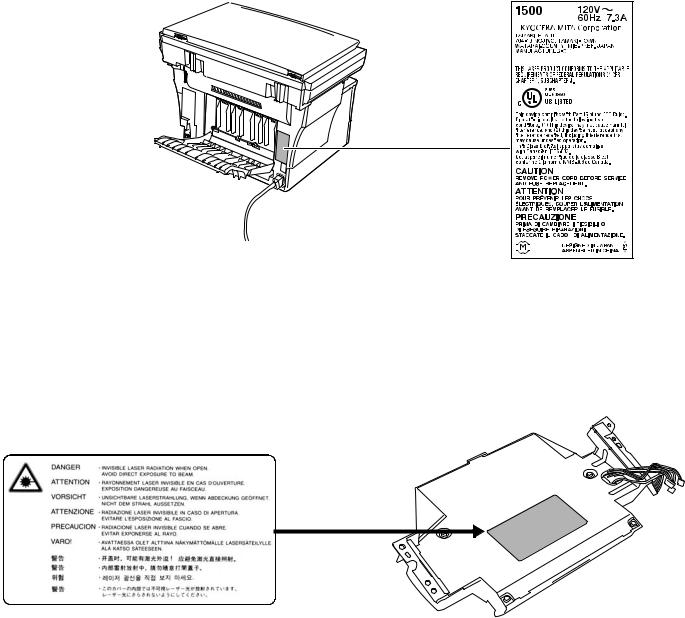
SAFETY OF LASER BEAM
1. Safety of laser beam
This copier has been certified by the manufacturer to Class 1 level under the radiation performance standards established by the U.S.DHHS (Department of Health and Human Services) in 1968. This indicates that the product is safe to use during normal operation and maintenance. The laser optical system, enclosed in a protective housing and sealed within the external covers, never permits the laser beam to escape.
2. The CDRH Act
A laser-product-related act was implemented on Aug. 2, 1976, by the Center for Devices and Radiological Health (CDRH) of the U.S. Food and Drug Administration (FDA). This act prohibits the sale of laser products in the U.S. without certification, and applies to laser products manufactured after Aug. 1, 1976. The label shown below indicates compliance with the CDRH regulations and must be attached to laser products marketed in the United States. On this copier, the label is on the rear.
3. Optical unit
When checking the optical unit, avoid direct exposure to the laser beam, which is invisible.
Shown at left is the label located on the cover of the optical unit.
4. Maintenance
For safety of the service personnel, follow the maintenance instructions in the other section of this manual.
5. Safety switch
The power to the laser unit is cut off when the upper front cover is opened.
1-5

CAUTION!
The power plug is the main isolation device! Other switches on the equipment are only functional switches and are not suitable for isolating the equipment from the power source.
ATTENTION!
Le débranchement de la fiche secteur est le seul moyen de mettre l’appareil hors tension. Les interrupteurs sur l’appareil ne sont que des interrupteurs de fonctionnement : ils ne mettent pas l’appareil hors tension.
WARNING
LAMP(S) INSIDE THIS PRODUCT CONTAIN MERCURY AND MUST BE RECYCLED OR DISPOSED OF ACCORDING TO LOCAL, STATE OR FEDERAL LAWS.
1-6

LIMITED WARRANTY FOR NEW COPIER MODEL 1500
1.Kyocera warrants the Customer’s new copier, and the new accessories installed with the initial installation of the copier, against any defects in material and workmanship for a period of one year, or 100,000 copies from date of installation by an Authorized Dealer, whichever first occurs. In the event the copier or an accessory is found to be defective within the warranty period, Kyocera’s only obligation and the Customer’s exclusive remedy shall be replacement of any defective parts. It is understood that Kyocera shall have no obligation to furnish labor.
2.This warranty is valid only as to the original retail purchaser (referred to as the “Customer”) of a new copier in the United States of America.
3.In order to obtain performance of this warranty, the Customer must immediately notify the Authorized Dealer from whom the product was purchased. If the Dealer is not able to provide service, write to Kyocera at the address below for the name and address of the Authorized Dealer in your area.
4.This warranty does not cover copiers or accessories: (a) which have become damaged due to operator negligence, misuse, accidents, improper storage or unusual physical or electrical stress, (b) which have used parts or supplies which are not genuine Kyocera brand parts or supplies, (c) which have been serviced by a technician not employed by Kyocera or an Authorized Dealer, or (d) which have had the serial number modified, altered, or removed.
5.This warranty does not cover Maintenance Kits or the components of Maintenance Kits, which consist of the drum unit, the fixing unit, and the developing unit. Kyocera shall give the Customer a separate warranty for these items.
6.This warranty gives the Customer specific legal rights. The Customer may also have other rights, which vary from state to state. Neither the seller, nor any other person is authorized to extend the time period, or expand this warranty on behalf of Kyocera.
7.THIS WARRANTY IS MADE IN LIEU OF ALL OTHER WARRANTIES, EXPRESS OR IMPLIED, AND KYOCERA SPECIFICALLY DISCLAIMS ANY IMPLIED WARRANTY OF MERCHANTABILITY OR FITNESS FOR A PARTICULAR PURPOSE. THIS WARRANTY SHALL NOT EXTEND TO, AND KYOCERA SHALL NOT BE LIABLE FOR, ANY INCIDENTAL OR CONSEQUENTAL DAMAGES WHICH MAY ARISE OUT OF THE USE, OR INABILITY TO USE, THE COPIER.
KYOCERA MITA AMERICA, INC.
225 Sand Road
Fairfield, New Jersey
07004-0008, USA
1-7
1-8
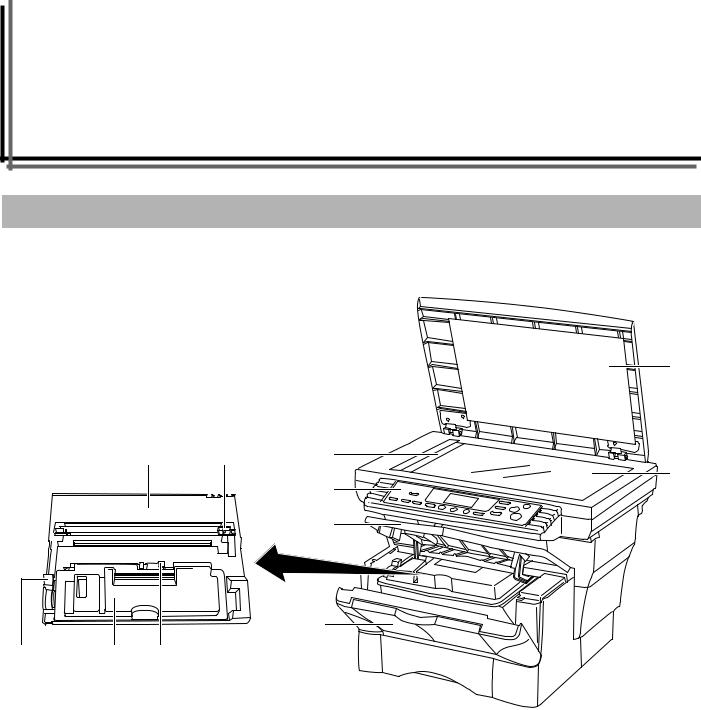
Section 2 NAMES OF PARTS
Main Body
(1)
(7) |
(11) |
(3) |
|
|
(2) |
|
|
(4) |
|
|
(5) |
(6)
(9) |
(8) |
(10) |
(1)Original cover
(Open/close this cover when you are setting the original on the platen.)
(2)Platen
(Set originals here for copying. Be sure to lay originals face-down and align them flush up against the left rear corner of the platen.)
(3)Original size indicator plate
(Be sure to align originals flush up against this plate when setting them on the platen.)
(4)Operation panel
(Perform copy operations here.)
(5)Upper front cover
(Open this cover when you need to replace the toner container or if a paper jam occurs inside the copier.)
(6)Front cover
(Open this cover when you need to replace the toner container or if a paper jam occurs inside the copier.)
(7)Process Unit
(Take this unit out when you need to replace the toner container or if a paper jam occurs inside the copier.)
(8)Toner container
(9)Lock lever
(Operate this lever when you need to replace the toner container.)
(10)Toner container release lever
(Operate this lever when you need to replace the toner container.)
(11)Charger cleaner
(Slide this knob back and forth when you need to clean the charger.)
2-1
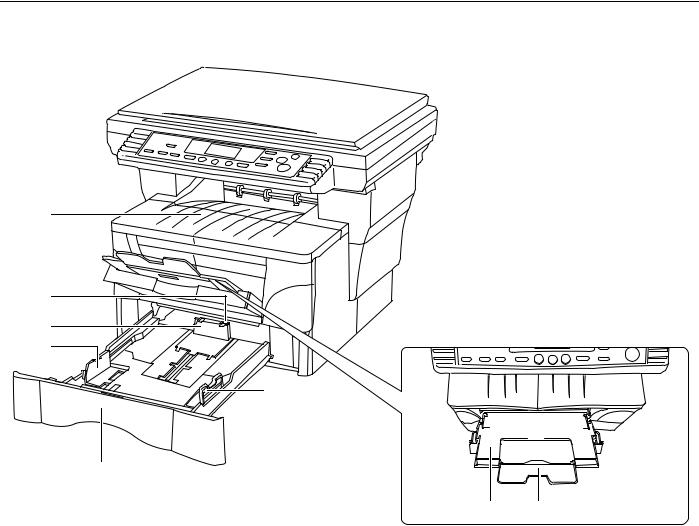
Section 2 NAMES OF PARTS
(16)
(15)
(14)
(13)
(13)
(19)
 (19)
(19)
(12)
(17) (18)
(12)Drawer
(This drawer has a storage capacity of 250 sheets of standard copy paper (80 g/m²).)
(13)Paper width guides
(Adjust these guides to fit the width of the paper that is to be loaded in the drawer.)
(14)Paper stopper
(Adjust this stopper to fit the length of the paper that is to be loaded in the drawer.)
(15)Stopper extension lock
(Use this lock when loading Folio or Oficio II size paper in the drawer.)
(16)Copy storage table
(Finished copies can be ejected and stored on this table. The copy storage table has a storage capacity of 150 sheets of standard copy paper (80 g/m²).)
(17)Multi-bypass tray
(Set paper on this tray when copying onto small-size or special paper.)
(18)Multi-bypass extension
(Pull out this extension when using the multi-bypass tray.)
(19)Insert guides
(Align these guides to fit the width of the paper that is to be set on the multi-bypass tray.)
2-2
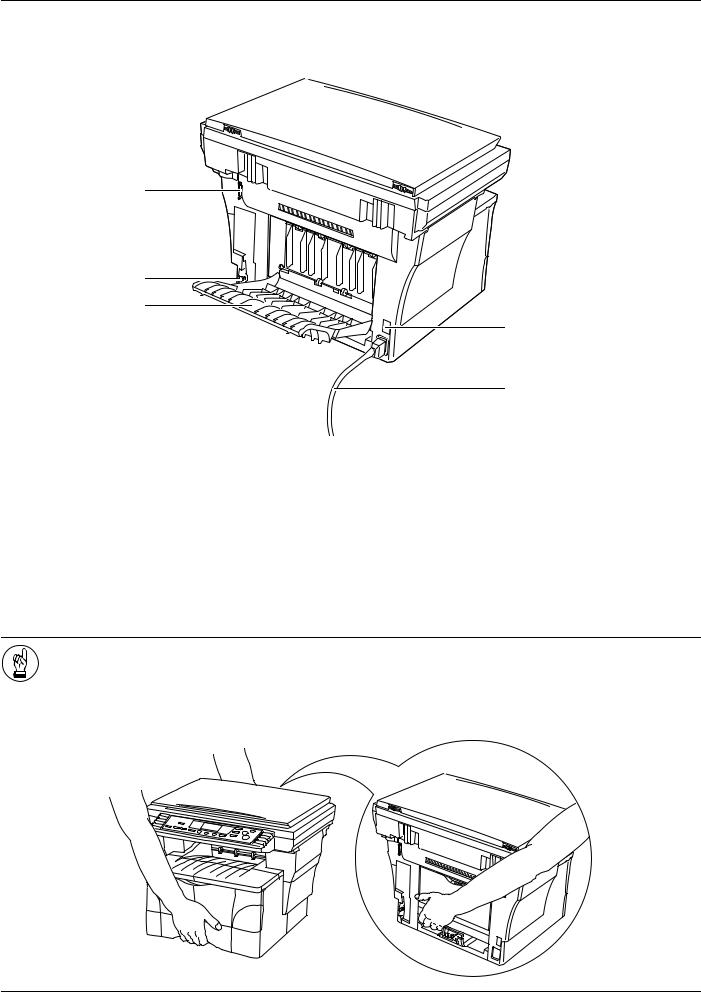
Section 2 NAMES OF PARTS
(23)
(24)
(21)
(20)
(22)
(20)Power switch
(Turn this switch ON ( | ) before copying.)
(21)Face-up tray
(Finished copies can be ejected and stored face-up on this tray. The face-up tray should be used when copying onto thick paper and other special paper. This tray has a storage capacity of 30 sheets of standard copy paper (80 g/m²) but only 1 sheet of special paper should be stored there at one time.)
(22)Power cord
(23)Document Processor connector
(Attach the connection cable here when installing the optional Document Processor.)
(24)Right cover anchor pin
(This pin must be removed and the right cover opened in order to access the slot for installing additional memory. If you need to add additional memory, contact your service representative or an authorized service center.)
IMPORTANT!
•Be sure to hold both the front and rear sides of the copier when carrying it, as shown in the illustration.
•Be sure not to pull the drawer out when holding the front of the copier.
•Be sure that the original cover is closed whenever transporting the copier.
•DO NOT attempt to carry the copier by holding only the top portion. Doing so may result in you dropping the copier and thereby damaging the copier and/or its covers.
2-3

Section 2 NAMES OF PARTS
Operation panel
(24)
(23) |
(22) |
|
|
|
(19) |
(18) |
|
|
|
(21) |
(20) |
|
|
|
|
|
(16) |
|
|
(12) |
(17) |
(4) |
(13) |
(2) |
(6) |
(5) |
(11) |
(8) |
(9) |
(7) |
(10) |
(14) |
(1) |
|
|
|
|
|
|
(15) |
(3) |
|
(1)Start key & indicator
(Press this key when you want to start copying. Copying will begin immediately if you press this key when the indicator is lit green.)
(2)Reset/Power key
(Press this key when you want to cancel the currently entered setting(s) and return to those registered for the initial mode. Press down on this key for at least 3 seconds when you want to engage the Off mode. When you want to release the copier from the Off mode, press any one of the keys on the operation panel. See page 2-5 for details on the initial mode and
page 4-7 for details on the Off mode.)
(3)Stop/Clear key
(Press this key when you want to stop copying. Press down on this key for at least 3 seconds when you want to view the total copy count. See page 6-12.)
(4)Copy quantity/magnification display
(Displays the number of copies to be made or the currently selected magnification ratio. When the “%” symbol is lit, the displayed number is the currently selected magnification ratio.)
(5)Exposure adjustment keys
(Press the left key when you want to make the copy exposure lighter and the right key to make the exposure darker. Press down on both keys at the same time for at least 3 seconds when you want to access the default settings mode.)
(6)Image quality select key
(Press this key when you want to select the desired image quality mode. See page 4-1.)
(7)Number of Copies / Zoom(+) key
(Press this key when you want to raise the number of copies to be made, as well as to increase the currently selected copy magnification ratio. Press this key as well during default settings in order to select the desired default item or setting.)
(8)Number of Copies / Zoom(-) key
(Press this key when you want to lower the number of copies to be made, as well as to decrease the currently selected copy magnification ratio. Press this key as well during default settings in order to select the desired default item or setting.)
(9)Recall%/Enter key
(Press this key when you want copy in the Zoom mode. Press this key as well during default settings in order to select the current default item or register the currently displayed setting. See page 4-4.)
(10)Reduce/Enlarge key
(Press this key when you want to use the Preset Zoom mode. See page 4-5.)
(11)Paper Select key
(Press this key when you want to switch paper feed between the drawer(s) and the multi-bypass tray. The indicator for the currently selected source of paper feed will be lit green. Press down on this key for at least 3 seconds when you want to access the default items for paper size selection. See page 4-1.)
(12)Thick Paper key & indicator
(Press this key when you want to copy onto thick paper. Make sure that the Thick Paper indicator is lit green. See page 3-9.)
(13)2in1/4in1 key & indicators
(Press this key when you want to copy with the Layout modes. Make sure that the 2in1 or the 4in1 indicator, as appropriate, is lit green. Press down on this key for at least 3 seconds when you want to access the default items for the Layout modes. See page 5-1 for more information on the Layout modes.)
2-4

Section 2 NAMES OF PARTS
(14)Sort key & indicator
(Press this key when you want to copy with the Sort mode. Make sure that the Sort indicator is lit green. See page 5-9.)
(15)Program key & indicator
(Press this key when you want to copy with the Program function. Make sure that the Program indicator is lit green. See page 5-10.)
(16)Add Toner indicator
(This indicator lights red when the toner supply has run low. See page 9-2.)
(17)Memory Overflow indicator
(This indicator lights red if the memory becomes full during scanning of originals. See page 8-1.)
(18)Upper drawer indicator
(This indicator lights green when the upper drawer is selected as the source of paper feed and it flashes green when the drawer has run out of paper.)
(19)Upper drawer misfeed indicator
(This indicator lights red if a paper jam occurs in the upper drawer.)
(20)Paper Feeder indicator
(This indicator lights green when the optional Paper Feeder is selected as the source of paper feed and it flashes green when the drawer has run out of paper.)
(21)Paper Feeder misfeed indicator
(This indicator lights red if a paper jam occurs in the optional Paper Feeder.)
(22)Multi-bypass tray indicator
(This indicator lights green when the multi-bypass tray is selected as the source of paper feed and it flashes green when the tray has run out of paper.)
(23)Multi-bypass tray misfeed indicator
(This indicator lights red if a paper jam occurs in the multi-bypass tray.)
(24)Document Processor indicator
(This indicator will light red if an original jam occurs.)
Initial mode (the state that the copier enters at the end of warm-up or when the Reset/Power key is pressed)
The upper drawer is selected as the source for paper feed, the number of copies to be made is set to “1” and “Text & Photo” is selected as the image quality mode.
*If the optional Paper Feeder is installed on your copier, it is possible for you to change which drawer will be automatically selected in the initial mode. (See “Default Drawer” on
page 6-2.)
*It is also possible for you to change which image quality mode will be automatically selected in the initial mode. (See “Image Quality Mode” on page 6-1.)
Auto Clear function
A pre-set number of seconds (between 10 and 270) after copying stops, the Auto Clear function will automatically engage and the copier will return to the same settings as those after warm up (initial mode settings).(However, the copy exposure setting will not change.) Copies can continually be made using the same settings (copy mode and number of copies) if the next batch of copying is started before the Auto Clear function engages.
*See “Auto Clear Time” on page 6-4 for information on changing the amount of time before the Auto Clear function automatically engages, and “Auto Clear ON/OFF” on page 6-3 for information on turning the Auto Clear function ON and OFF.
Auto Drawer Switching function
If two drawers contain the same size of paper and the paper in one drawer runs out during copying, the Auto Drawer Switching function will switch paper feed from the empty drawer to the other drawer that still contains paper so that copying can continue non-stop.
*The optional Paper Feeder is required in order to use the Auto Drawer Switching function.
*It is possible for you to turn the Auto Drawer Switching function OFF. (See “Auto Drawer Switching ON/OFF” on page 6-2.)
2-5

Section 2 NAMES OF PARTS
2-6
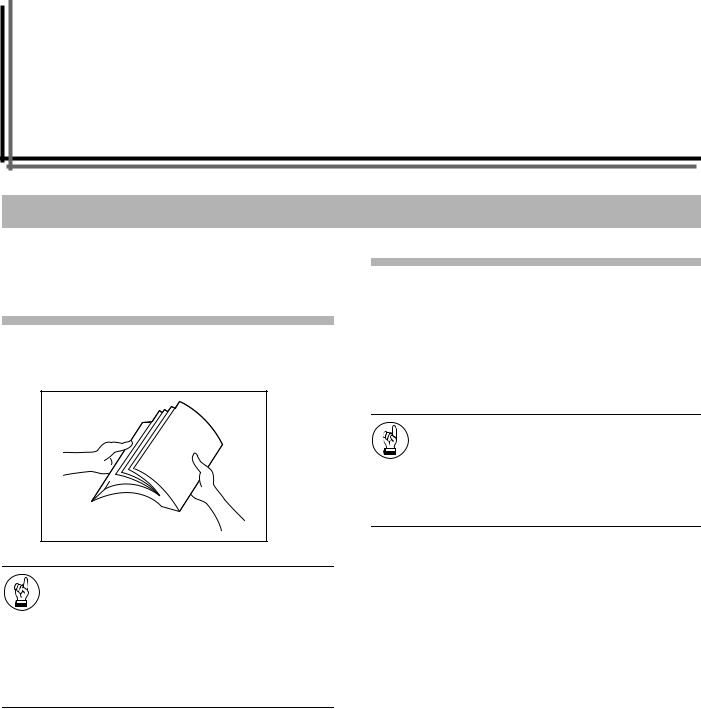
Section 3 PREPARATIONS
Loading paper
Copy paper can either be loaded into the drawer(s) or set on the multi-bypass tray.
Note when adding paper
After taking new paper out of its packaging, be sure to fan through them a few times to separate the sheets before loading the paper into a drawer or setting it on the multi-bypass tray.
IMPORTANT!
•If you ever use paper that has already been copied onto, be sure NOT to use paper that still has staples or clips attached to it. Doing so may result in lowered copying quality or even damage to the copier.
•If you are using paper that has been folded or is curled at all, straighten it out before loading the paper into a drawer or setting it on the multi-bypass tray. Failure to do so may result in a paper jam.
Loading paper into a drawer
Standard copy paper (60 g/m² – 90 g/m²), thick paper (90 g/m² – 105 g/m²), recycled paper, or color paper can be loaded into each drawer.
Up to 250 sheets of standard copy paper (80 g/m²) can be loaded into each drawer at one time.
The sizes of paper that can be loaded into the drawers are: A4, A5R, Folio, 8 1/2" × 14" (Legal), 8 1/2" × 11" (Letter) and 8 1/2" × 13" (Oficio II).
IMPORTANT!
•When loading copy paper for the first time, or when changing paper sizes, be sure to use the operation panel to register the size of paper that will be loaded in the corresponding drawer. (See page 3-4.)
•When using thick copy paper (90 g/m² – 105 g/m²), be sure to select the Thick Paper mode. (See page 3-9.)
3-1
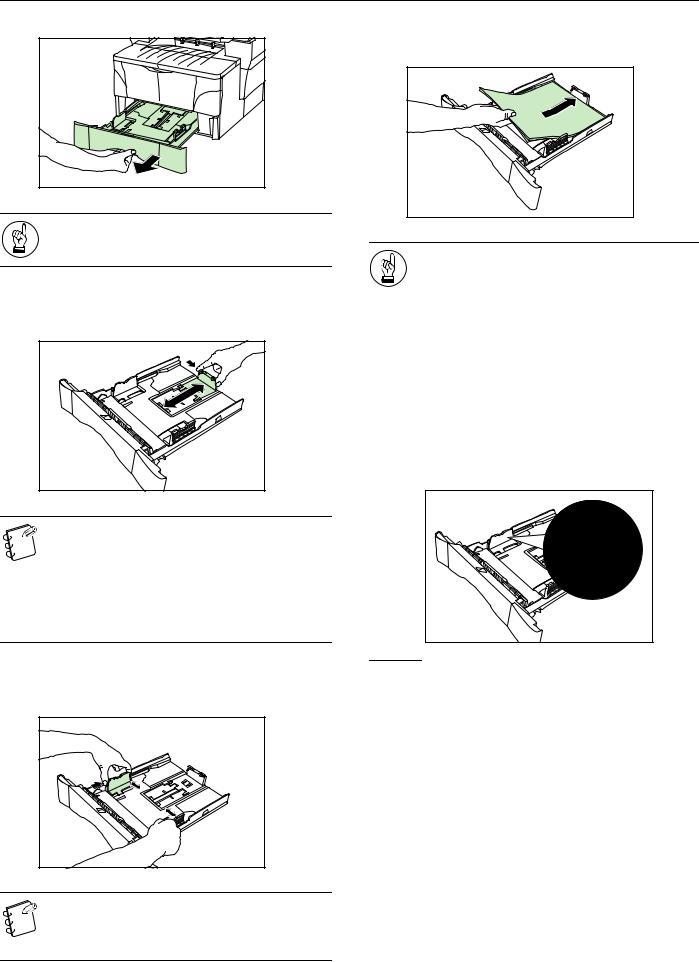
Section 3 PREPARATIONS
1 Pull the drawer all the way out of the copier.
IMPORTANT! |
When pulling the drawer out of the copier, be sure to support it so that it doesn’t fall out suddenly.
2 Adjust the paper stopper in the rear portion of the drawer by pressing in on the release buttons and sliding the paper stopper to the fit the size of the paper being loaded.
NOTES |
• The paper sizes are marked on the bottom of the drawer.
•The factory default setting is for A4/Letter size paper.
•For information on adjusting the paper stopper for Folio or Oficio II size paper, see “Adjusting the paper stopper for Folio or Oficio II size paper” on page 3-3.
3 Adjust the paper width guides on both sides of the drawer by pressing in on the release buttons and sliding the guides to fit the width of the paper being loaded in the drawer.
4 Set the paper in the drawer so that the leading edge is aligned against the paper stopper, but making sure that none of the paper gets caught on the overhanging tabs.
IMPORTANT!
•ALWAYS adjust the paper stopper and paper width guides BEFORE loading paper into the drawer. Failure to do so may result in skewed paper feed and/or a paper jam.
•Make sure that the paper is set securely against the paper stopper and the paper width guides. If there is any gap between the paper and the stopper or guides, readjust the paper stopper and/or the paper width guides, as appropriate.
•When you are loading paper into the drawer, make sure that the side to be copied onto is facing downward.
•Be sure to load paper so that it is not folded or curled, etc.
•DO NOT load more paper than indicated by the lines located on the width guides.
NOTES
•The paper sizes are marked on the bottom of the drawer.
•The factory default setting is for A4/Letter size paper.
3-2
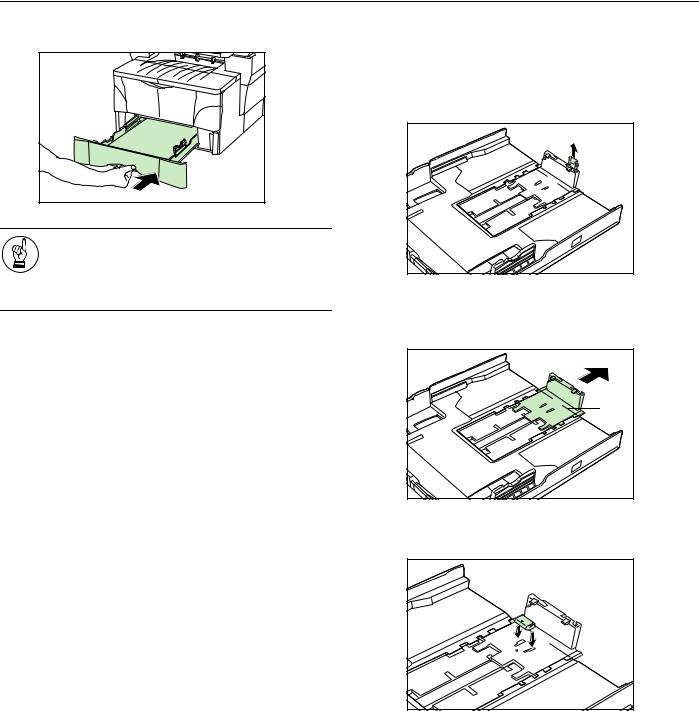
Section 3 PREPARATIONS
5 Push the drawer securely all the way back into the copier until it stops.
IMPORTANT! |
If you will not be using the copier for a prolonged period of time, remove all paper from the drawer(s) and seal in its original packaging in order to protect it against moisture.
Adjusting the paper stopper for Folio or Oficio II size paper
Perform the following procedure to adjust the paper stopper when you want to load Folio or Oficio II size paper into the drawer.
1 Remove the stopper extension lock from the paper stopper.
2 Slide the paper stopper towards the rear of the drawer until the grooves (1) that are cut into the paper stopper are aligned with the rear edge of the drawer.
(1) |
3 Insert the stopper extension lock into the holes in the paper stopper.
3-3
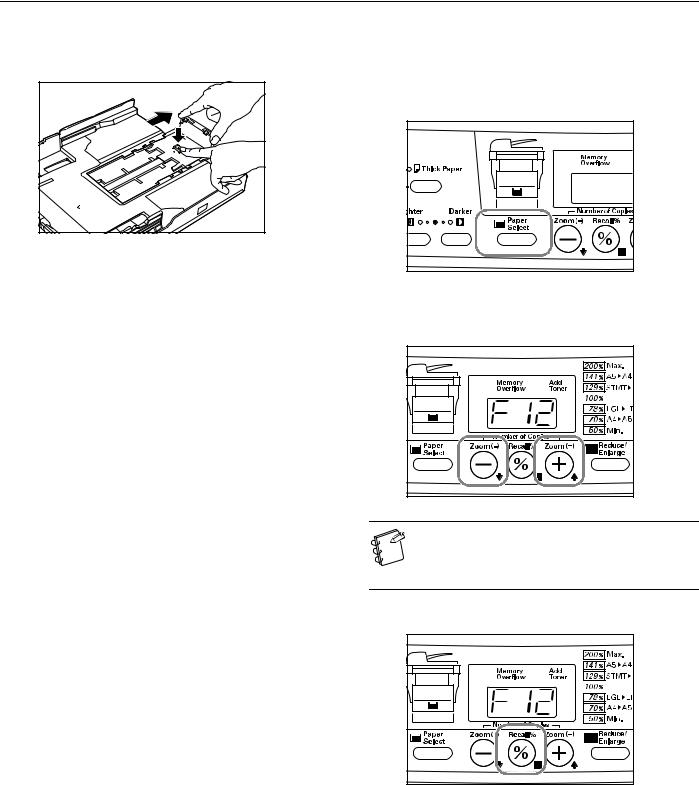
Section 3 PREPARATIONS
4 Press down on the stopper extension lock and slide the paper stopper towards the rear of the drawer to set the lock into place. The paper stopper is now in position for Folio and Oficio II size paper.
Selecting the paper size
Perform the following procedure to use the operation panel and select the size of paper that is loaded in the drawer.
1 Press down on the Paper Select key for at least 3 seconds. The first default item for paper size selection will be shown.
2 Press the Number of Copies / Zoom(+) or Number of Copies / Zoom(-) key until “F12” (Default item: Upper Drawer Paper Size) is shown.
NOTE |
To select the size of paper loaded into the optional Paper Feeder, make sure that “F13” (Default item: Paper Feeder Paper Size) is shown.
3 Press the Recall%/Enter key.
3-4
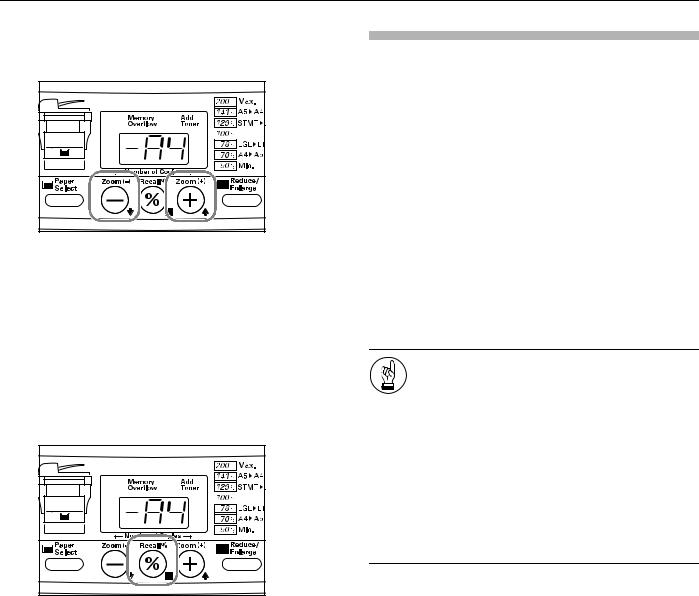
Section 3 PREPARATIONS
4 Press the Number of Copies / Zoom(+) or Number of Copies / Zoom(-) key to select the appropriate paper size. The displayed code numbers refer to the available paper sizes as explained in the following table.
Code number |
Size |
-A4 |
A4 |
|
|
-A5 |
A5 |
|
|
-Fo |
Folio |
|
|
-Lg |
Legal (8 1/2" × 14") |
|
|
-Lt |
Letter (8 1/2" × 11") |
|
|
-o2 |
Oficio II (8 1/2" × 13") |
|
|
5 Press the Recall%/Enter key.
The displayed numbers will flash and the copier will return to a copy-ready state.
Setting paper on the multi-bypass tray
Standard copy paper (60 g/m² – 90 g/m²), thick paper (90 g/m² – 163 g/m²), color paper, OHP transparencies and letterhead paper can be set on the multi-bypass tray.
ALWAYS use the multi-bypass tray when copying onto special paper.
The sizes of paper that can be set on the multi-bypass tray are as follows:
Inch Specification
8 1/2" × 14" (Legal) – 5 1/2" × 8 1/2" (Statement)
Metric Specification
A4 – A6R, and Folio
The types of paper and the number of sheets that can be set on the multi-bypass tray at one time are as follows:
•Standard paper (80 g/m²): 50 sheets
•Thick paper (120 g/m²): 25 sheets
•Thick paper (160 g/m²): 10 sheets
•OHP transparencies: 1 sheet
IMPORTANT!
•After setting paper on the multi-bypass tray, be sure to use the operation panel to select the size of that paper. (See page 3-7.)
•If you want to copy onto non-standard size paper, be sure to use the “F15” (Non-Standard Size Paper Width) default item to register the paper size. (See page 6-3.)
•When using thick copy paper (90 g/m² – 105 g/m²), be sure to select the Thick Paper mode. (See page 3-9.)
•When using OHP transparencies, be sure to use a type of film that can withstand the heat of the fixing process. The following products are recommended: Arkwright (LTR)
3M PP2500 (A4)
3-5
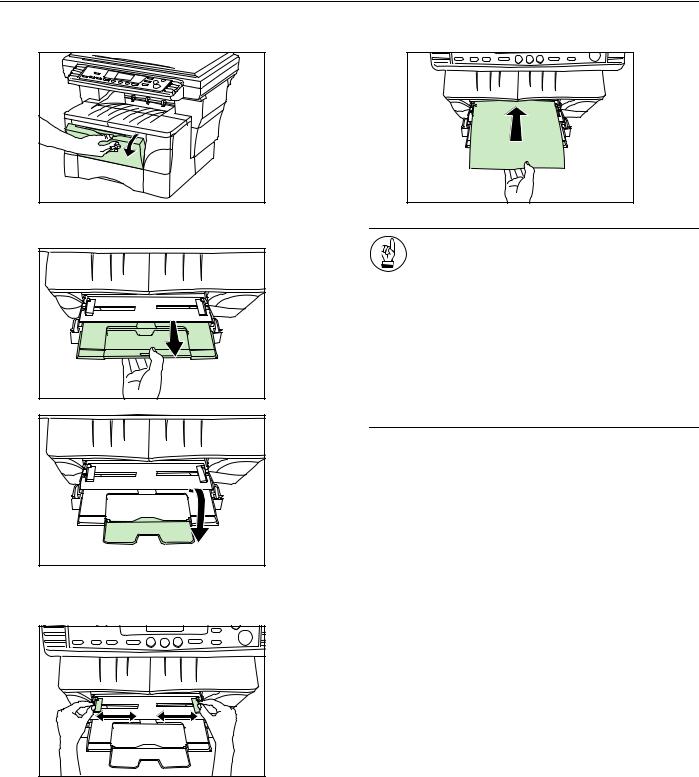
Section 3 PREPARATIONS
1 Open the multi-bypass tray towards you until you hear it click into place.
2 Pull out the multi-bypass extension and then flip it open.
3 Adjust the insert guides to fit the width of the paper that is to be set on the multi-bypass tray.
4 Slide the paper all the way in, along the insert guides, as far as it will go.
IMPORTANT! |
•Only set paper on the multi-bypass tray when you are planning to use that tray to feed paper. DO NOT leave paper on the multi-bypass for long periods of time.
•When you are setting paper on the multi-bypass, make sure that the side to be copied onto is facing upward.
•When using 8 1/2" × 14" (Legal), 8 1/2" × 13" (Oficio II) or Folio size paper, it is recommended that you load that paper into the drawer(s) and have paper fed from there. If you do need to use the multi-bypass tray and such paper does not feed smoothly, continue to support the paper by its trailing edge until all of the paper has been fed into the copier.
3-6
